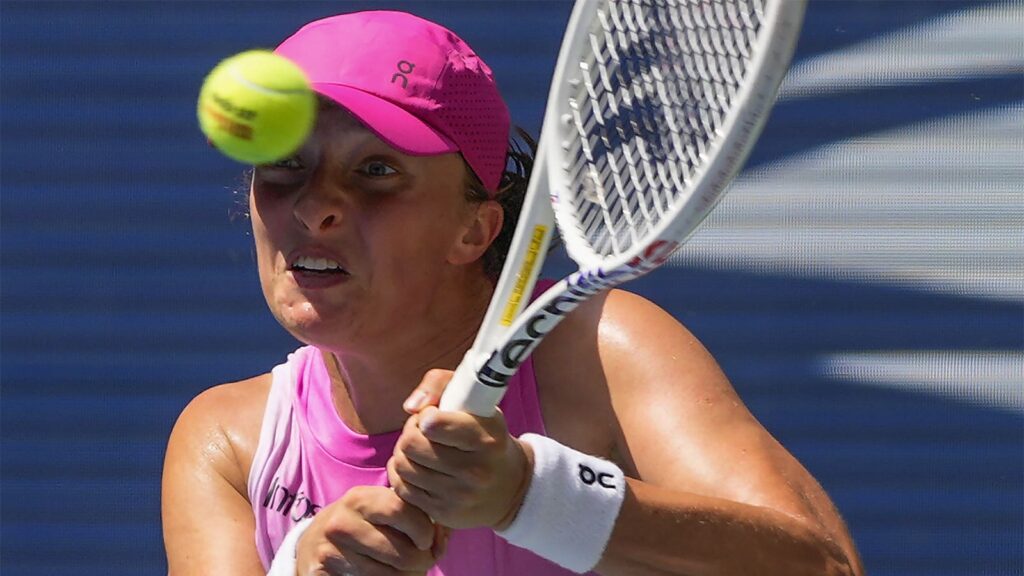It’s nothing new for tennis players to worry aloud about their sport’s overcrowded calendar, too-tough season, and too-short offseason.
No. 1-ranked Iga Swiatek added an additional complaint this week at the U.S. Open: Athletes are not being heard when they express concerns about potential harm to mental and physical health caused by having more tournaments that run longer and new rules that require participation in more events — and, she added, those athletes are not being consulted enough by the professional tours.
“We want to at least be in the loop,” said Swiatek, a five-time Grand Slam champion who plays her second-round match at Flushing Meadows on Thursday. “It would be nice for us to have some impact, because I don’t think our sport is going in the right direction.”
She’s hardly alone in harboring those doubts.
“The tours are not united enough to collaborate without egos and money getting involved. The players are absolutely getting crushed in so many ways — physically, mentally, financially,” said Mackie McDonald, a Californian who beat Rafael Nadal at the 2023 Australian Open and lost to No. 1 Jannik Sinner at the U.S. Open on Tuesday. “Having a normal life? We’re far from it. And then actually getting what we deserve, especially at the Slams? It’s sad. I’ll put it that way.”
Swiatek raised questions about the schedule in a TV interview during the Cincinnati Open tuneup event earlier this month — and drew online criticism from former player Yevgeny Kafelnikov, who wrote on social media: “is someone pushing you to play ???”
That ignored Swiatek’s basic point, but it also ignored this: Yes, she and female players do need to enter more tourneys this season under new Women’s Tennis Association (WTA) Tour rules. There’s also the understanding that the only way to get more rankings points is to play — and, of course, win — with frequency.
The conflict, as explained by three-time major semifinalist Elina Svitolina, is this: “You want to play more, because you want to be high in the rankings and you want to win tournaments, but also you need to take care of your mental health and your physical [condition].”
In 2024, aside from the four Grand Slam tournaments, women must participate in 16 WTA events, up from 10 in 2023. The tour said players have been averaging about 20 tournaments each per season over the past several years.
Another thing players don’t seem to love is the increasing number of 2-week combined tournaments for women and men at the tier below the Slams, which reduces breaks between events.
“We don’t have time to work on stuff or live peacefully,” Swiatek said, “because from one tournament we’re going straight to another.”
She also noted that the 2025 season actually begins in the last week of December 2024.
“There is no question the professional tennis season is long, and we recognize the demanding schedule experienced, especially, by players competing at the highest level. … The new schedule, which was developed in consultation with representatives of players and tournaments, does not require players (on average) to play more than they would have played in previous years, but provides more predictability for the top players and better pathways for aspiring players,” new tour CEO Portia Archer said. “The WTA will continue to listen to player and tournament feedback and will be open to making adjustments in the future as may be appropriate.”
The Association of Tennis Professionals men’s tour has eight mandatory Masters 1000 events annually, and players are supposed to go to four tournaments at the next level down, called 500s.
Holger Rune, the U.S. Open’s 15th seed, said after losing in the first round he’s been dealing with a knee problem and probably should have taken time off but felt compelled to keep competing.
“We want to be ready and play the best tournaments, but the schedule is so tight. It’s probably the tightest sports schedule that there is, I think. There’s December, when we’re supposed to be off. And then there’s exhibition events and everything,” Rune said. “It’s almost ongoing, 24/7.”
That can lead to injuries. Or burnout. Or simply being unable to put forth one’s best.
Donna Vekic is in the midst of a breakthrough season, having reached her first Grand Slam semifinal at Wimbledon in July and captured a silver medal at the Paris Olympics in August. But the 28-year-old Croatian said after her first-round victory Monday she got sick after both of those events.
“The schedule is absolutely brutal. When you compare it to other sports that have an actual offseason — we have, what, a month, a month and a half? You don’t even have time to relax, get rest, before you have to start training again,” Vekic said. “I’m not sure it will change, but it’s very unhealthy.”
She tried to unplug after Wimbledon, spending 9 days vacationing on a boat. But that didn’t exactly leave her refreshed.
“You probably feel fresh,” Vekic said, “at the beginning of the year. … That’s about it.”
Please enable JavaScript to view the

